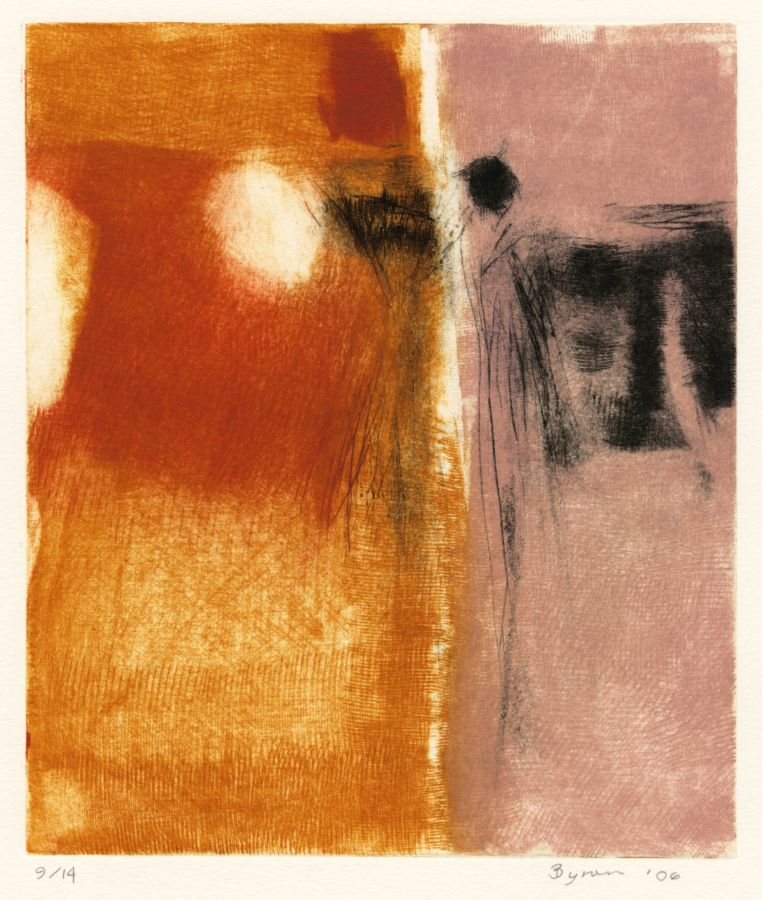Somesbar is a color mezzotint with roulette and drypoint created in 2006 by American artist Byron McClintock. It is pencil signed Byron, dated, and editioned 9/14. Somesbar was printed by the artist on ivory Rives heavyweight wove paper and the platemark measures 9-7/8 x 8-3/8 inches.
Like many of McClintock’s abstract mezzotints, Somesbar is a reference to an actual place. Somes Bar is centered at the confluence of the Klamath and Salmon Rivers in Northern California. It remains an unincorporated community in Siskiyou County and its evolution began with the onset of gold mining and homestead ranching. According to Dominick A. Dellasala, Ph.D., “The Klamath-Siskiyou ecoregion of Northwest California is one of the most diverse temperate forest regions on earth. To the locals, the ecoregion goes by many names: the Klamath Knot for its rugged mountain ranges: State of Jefferson, for a local secession movement popularized in 1941; and Bigfoot Country, for the reputed sightings and mythical connection this creature inspires in indigenous communities. To biogeographers and conservationists, however, this area has many accolades, including designation as a World Conservation Union global center of plant diversity, a World Wildlife Fund Global 2000 ecoregion and proposed United Nations Educational, Scientific and Cultural Organization (UNESCO) designation as a biosphere reserve.”
William Byron McClintock was born in Klamath Falls, Oregon on 19 March 1930 to Eletha Humphrey and Robert McClintock. The family moved to Seattle where Bryon attended Queen Anne High School. In 1946, he joined the Merchant Marines, sailing throughout the Pacific.
He moved to San Francisco in 1949 and enrolled in the California School of Fine Arts (CSFA) where he studied under Edward Corbett, Richard Diebenkorn, and James Budd Dixon. During those years he served as class monitor for Dixon’s printmaking class and printed lithographs for many of the students. In the early 1950s, McClintock tended bar at Vesuvio Café, a saloon that was an important hangout for the Beat artists, and he shared a studio in the Mission District with Ernest Briggs. In 1954, McClintock was included in the exhibition American Prints of the 20th Century at the Museum of Modern Art, New York. In the press release for this exhibition, William S. Lieberman, Curator of Prints, stated, “Color lithography is still much less developed in the United States than in Europe. Rapid advances, however, are being made by artists such as will Barnet, Ralston Crawford and Bryon McClintock.”
McClintock served in the U.S. Army between 1953 and 1955. After his discharge, he returned to San Francisco where he co-owned Acme Photoengraving, a photoengraving business specializing in commercial advertising work, until 1980. During the 1960s McClintock exhibited his paintings at the John Boles Gallery in San Francisco and, in the late 1970s, he purchased a large studio on Howard Street and bought a press to return to printmaking.
New York Abstract Expressionist print collector, Charles Dean, rediscovered Byron McClintock in the late 1990s. The Whitney Museum of American Art purchased a few of McClintock’s prints and included them in their Recent Acquisitions exhibition in 2004. At Dean's urging, McClintock traveled to New York from the Pacific Northwest to see his work hanging in the Whitney. McClintock's work is also in the collections of the Museum of Modern Art, New York; and the Library of Congress, Washington, D.C.
Bryon McClintock died at home in Tigard, Oregon on 31 March 2022.



